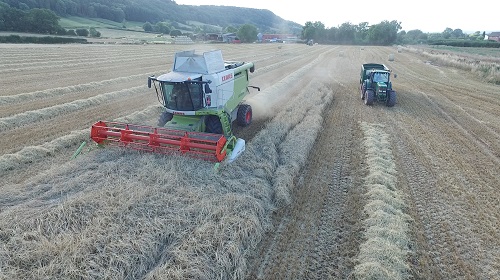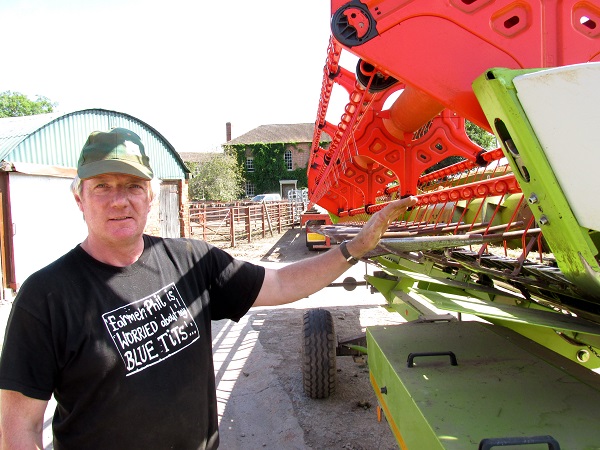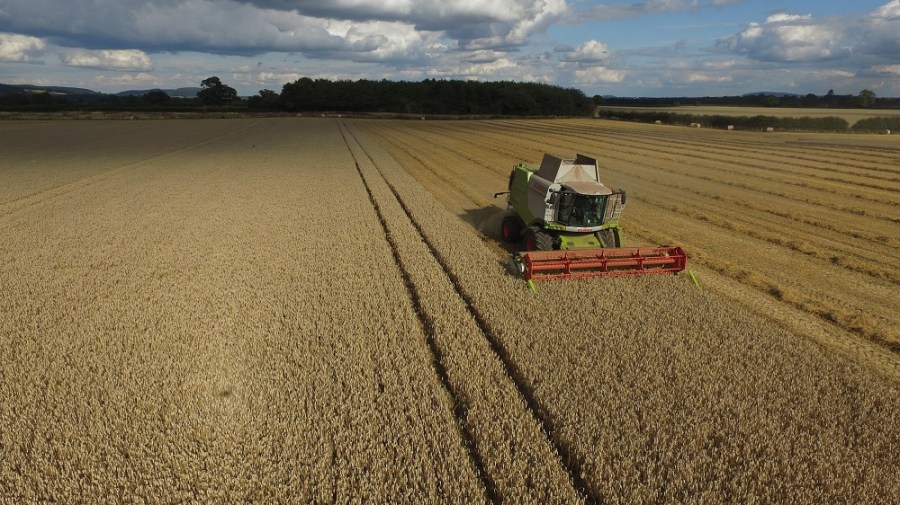For over 50 years there’s been a Claas combine gathering in crops at Lower Blakemere Farm in Herefordshire. CPM visits to find out why.
I like its ability to cope with awkward crops in a wide range of sometimes quite difficult conditions.
By David Jones
Philip Gorringe is no stranger to Claas combine harvesters. Including the Standard Matador that his father bought in 1964, He’s pretty sure that the family business has had a total of 20 Claas machines in a row. Without a break.
No surprise, then, that the current incumbent is a Lexion 650 that’s just finished work in its second summer, having been preceded by a pantheon comprising a Protector 4, several Senator 70s, Dominators 76, 88, 98 and 204 and Lexions 430, 460 and 550.

The Lexion 650 is the latest in an unbroken row of about 20 Claas combines at Lower Blakemere Farm.
Home to all these combines has been Lower Blakemere Farm, Blakemere, in Herefordshire’s Wye Valley, a 352ha mixed holding. This is made up of 203ha on an AHA tenancy, 55ha on a FBT tenancy with the Duchy of Cornwall, 65ha on a FBT with a private landlord and an off-lying 30ha, which is owned, alongside the River Wye at Preston-on-Wye.
Soil types range from river silt through loam with gravel to heavier red Herefordshire clay soils. The land rises to approximately 275m above sea level at its highest point, with some fairly steep ground running down onto more level land in the river valley.
“Some of the land next to the river does flood,” Philip says, “starting at about a 12ft (3.6m) flood, with nearly all of it flooding at 20ft (6m).

“Just over 40ha – all at Lower Blakemere – of the steeper or more disadvantaged land is in permanent pasture or ELS/HLS, providing grazing for 75 single-suckler cattle. These are housed over the winter, calving from Jan 1, and calves are sold as stores in the autumn to one farmer customer. We’re currently Bovine TB-free – just!”
All of the arable cropping here is grown for seed, comprising winter wheat (104ha), winter barley (73ha), vining peas combined for seed (30ha), amenity perennial ryegrass (79ha), which is cleaned and certified on-farm and forage rape (14ha).
“We have three full-time employees, including me, one of whom is a day-release student. We also have one extra over the harvest period, who, this year, has been our son Monty, who’s half way through his agriculture course at Harper Adams,” says Philip.
The farm also supplies Wiggly Wigglers, a business based at Lower Blakemere and run by Philip’s wife Heather and her niece, San, and is a mail order birdseed/composting and garden products company. A small area of red wheat is grown for this market. Also based on the farm is The Great British Florist (a subsidiary of WW) for which flowers and foliage are grown.
Completing the ancillary activities here is the supply of Bridgestone, Dunlop and Maxxis racing kart tyres to the South Wales region – and to the RAF. “This is run in conjunction with racing TKM Extreme Karts ourselves at national level,” Philip explains.
While the business itself may be diverse and varied, it’s the familiarity Philip values most with his Claas Lexion 650. “As a long term Claas user, I find that it’s intuitive to operate, and the CEBIS I regard as a major plus point. I like its ability to cope with awkward crops in a wide range of sometimes quite difficult conditions,” he says.
“The header is particularly good and the knifedrive is a significant step forward in crops that are difficult to cut – which, for us is principally grass. The latest Autocontour system is excellent. Other general points to mention are reliability, ease of servicing and the good back-up we receive.
“Going back to CEBIS, if we could change anything, we would ideally like three settings options on the HotKey – in effect, uphill, on the level and down-hill. Also, it would be good to be able to alter the header aspect – tilting forward or back – without the expense of having to go for the Montana model, which can do this.
“We have a slight problem with lifters in grass: the new bolted section knives catch the lifters and bend them. In addition, the lifters appear to be too weak and the grass is able to crush them.”
But Philip is prepared to accept that this may be a problem that’s peculiar to his situation, and that it may be due to attempting to use the lifters for a task that they weren’t designed to do. Nevertheless, he says, he finds them an essential part of the equipment for grass. “We use the ‘low cut’ variant with a flat bottom,” he adds.
One of the long-term aims that Philip has been striving to achieve is to improve the combine’s performance with herbage seed and his historic allegiance to both Claas and his local dealership, Morris Corfield, has paid dividends. “Over the years, with Claas, we’ve focussed on concave adjustment, the nitrogen accumulator, the stone trap and on Vario headers, impellor covers, the straw spreader and grain tank agitators.
“Both manufacturer and dealership have been extremely helpful in addressing issues as they arise and many of the solutions that they’ve arrived at are now fitted as standard or are available as options,” he states.
The relationship with Corfields arose at the time Ross Farm Machinery lost the Claas dealership. “We bought a couple of combines through RFM, but they were really from Corfields,” Philip recalls. “Then, eventually, the RFM connection became a bit superfluous and we started to deal with Corfields direct – in the person of Norman Duppa.
“We’ve always got on very well with Norman and he’s always receptive to ideas and problem solving. I think our last seven combines have come from Corfields and they’ve been closely involved in the development of the Lexions for our specific requirements. Not all the features of the earlier Lexions were suited to herbage seed, but, together with Claas, Norman – and, latterly, Jason Parkes – all problems have been overcome successfully.”
Morris Corfield has one of the larger parts stocks within the Claas dealership network which, on occasions, Philip says, has been “hugely beneficial.”
Dialogue is just restricted to talking with suppliers and dealers, however. Philip devotes a good deal of his ‘spare’ time attempting to narrow the communication gap between producer and consumer.
“I’ve long felt that we, as farmers, can’t expect the public in general – our customers – to support us without providing them with the opportunity to see what we do and ask us questions about it,” he says.
“Having become involved in LEAF’s Open Farm Sunday initiative and being able to show people around the farm, I’ve found it to be an educative experience for both sides. I get to know what peoples’ concerns are, where there are gaps in the information flow – and they get the opportunity to allay them or fill in those gaps.
“I’ve found that if I can’t justify what we’re doing, then it’s only sensible to look closely at why we do it! Those who visit on OFS are also interested in the history of the farm and the extent to which it forms an essential part of the local community.”
As for social media, Philip believes this is a logical extension of this communication process. “It allows discussion, good and not so good, and comment, both positive and negative,” he says. The hope is, though, that in the longer term it leads to a better understanding of the way our food is produced and of the methods and practices involved. The ability to post photos adds to the opportunities to engage a wider audience.”
Social media has also given farmers the opportunity to communicate with each other – the Combine Operators group on Facebook is a good example, Philip believes, with #Clubhectare on Twitter being another.
“As a farmer, interaction with others is usually a very positive experience,” he feels. “The dire weather in 2012 and its consequences were a good example of how sharing problems and experiences, and so on, always helps. The birth of ForageAid was another great example that I doubt would have happened without the existence of social media.”
Farm facts:
Lower Blakemere Farm, Blakemere, Herefordshire
- Farmed area: 352ha
- Cropping (all grown for seed): Winter wheat, winter barley, vining peas (for seed), amenity perennial ryegrass, forage rape
- Livestock: 75 single-suckler beef cattle
- Soils: River silt, loam with gravel, heavy red Herefordshire clay
- Elevation: 275m above sea level
- Combine: Claas Lexion 650 combine, with 6.8m Vario header
- Mainline tractors: Claas Axion 820, 810, John Deere 6820, 6320, 6320
- Loader: JCB 526-56, 520-50
- Cultivation: Kverneland EG300 5F reversible plough; 4m Simba Freeflow drill; Dowdeswell power harrow or Drillmate (as required for grass and rapeseed); 6.5m Väderstad Carrier; Kverneland 6m cultivator and 5.5m discs
- Sprayer: Knight 1200-litre mounted 24m sprayer, with GPS
- Spreader: solid fertiliser spreader




